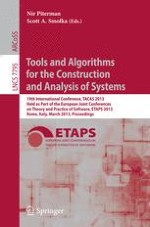2013 | Buch
Tools and Algorithms for the Construction and Analysis of Systems
19th International Conference, TACAS 2013, Held as Part of the European Joint Conferences on Theory and Practice of Software, ETAPS 2013, Rome, Italy, March 16-24, 2013. Proceedings
herausgegeben von: Nir Piterman, Scott A. Smolka
Verlag: Springer Berlin Heidelberg
Buchreihe : Lecture Notes in Computer Science
